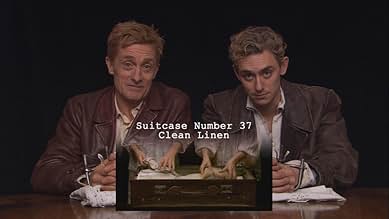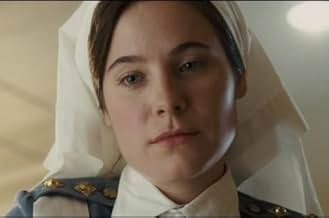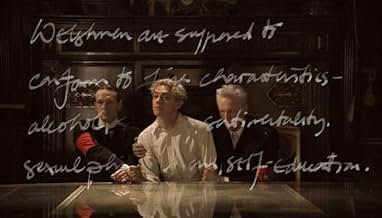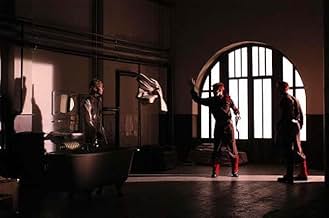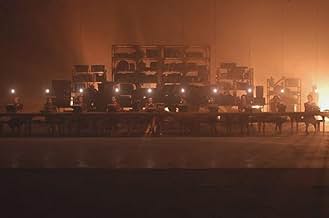Le valigie di Tulse Luper - La storia di Moab
- 2003
- 2h 7min
Aggiungi una trama nella tua linguaThe first of three parts, we follow Tulse Luper in three distinct episodes: as a child during the first World War, as an explorer in Mormon Utah, and as a writer in Belgium during the rise o... Leggi tuttoThe first of three parts, we follow Tulse Luper in three distinct episodes: as a child during the first World War, as an explorer in Mormon Utah, and as a writer in Belgium during the rise of fascism. Packed with stylistic flourishes, it's a dense, comic study of 20th century his... Leggi tuttoThe first of three parts, we follow Tulse Luper in three distinct episodes: as a child during the first World War, as an explorer in Mormon Utah, and as a writer in Belgium during the rise of fascism. Packed with stylistic flourishes, it's a dense, comic study of 20th century history, revolving around the contents of one man's suitcases.
- Premi
- 1 vittoria e 1 candidatura in totale
- Jan Palmerion
- (as Jordi Molla)
- Pip
- (as Nilo Mur)
Recensioni in evidenza
Greenaway continues to evolve his directorial style, overlapping images and sounds, embedding windows within windows, mixing media. The results are often confusing, sometimes stunning, never boring.
I wondered if Greenaway was hinting that this was in some sense an autobiographical piece. Tulse Luper is cited as the author of 'The Belly of an Architect' and in a list of his lost works appears 'The Falls', both earlier films by Greenaway.
Of course it might just be the director playing games. A clip from 'A Zed and Two Noughts' is used at one point, and there is a character named 'Cissie Colpits', the name of the three women in 'Drowning by Numbers'. I suspect there might well have been many more references to earlier films in there.
This is closer in style to 'Properos Books' or 'A TV Dante' than some of his earlier works such as 'The Cook, the Thief, his Wife and her Lover'. Narrative flow has been sacrificed in part for creating a cinematic work of art. Nothing wrong with that in my opinion though, when the result is a film like this. Sit back and let the experience wash over you.
The film begins with showing us actors auditioning for roles, which is also used later. Tulse is a young boy with his friend Martino Knockavelli in the back yard of his house in Newport, Wales. A red brick wall collapses on Tulse and then we progress through history, with war footage in the background. Tulse travels to Moab where he is abused and jailed, and then later travels to Antwerp and faces the sinister Red Fox fascists. Throughout the film a small box with the head of a talking expert inside appears (like A TV Dante) describing the background of what is happening. Characters are noted on screen with name and number when they appear. It was fun reading all of Luper's Lost Films that scrolled down the screen, as well as seeing the other suitcases (suitcases 1 - 21 are featured in this film). It was good to see former Greenaway films - Vertical Features Remake, Water Wrackets, A Zed & Two Noughts, and The Belly of an Architect - referenced and appear. Greenaway is really experimenting here with image and sound, using repetitive sound at times giving an echoing effect. He plays with connecting numbers to draw shapes on screen when Percy strikes Tulse. Sometimes the screenplay is shown on screen after the characters have said it. The cinematography by Reinier Van Brummelen is good. The music by Borut Krzisnik is superb and feels appropriate. In the acting stakes Caroline Dhavernas is the stand out, and J.J. Feild does a capable job as Tulse. It's a film that (like all Greenaway films) needs to be watched several times. I look forward to seeing Vaux to the Sea.
This is the first film that I have watched at a film festival in about ten years that I can honestly say the vast majority of the audience left the theatre in a state of bemused disgust. It was one of the least enjoyable film experiences I have ever had, right up there with Salo, and UFO: The Movie. Maybe if viewed in sequence with the other parts of the production it might have some worth, but i doubt it. At best it may serve as an educational tool to the many film schools out there...
His fundamental notions of the world are built on overlapping conceptual frameworks, ordered frameworks. In this, he follows the Joycean tradition of "Finnegans Wake," which layered all sorts of frameworks from Kabbalistic, Vican, mythological, even geographic sources. It was all merged according to a dream logic since we had no other template in that day and used every lexical and literary device he could muster.
Where Joyce had to make do with dream-layering, our Peter gets to use already familiar web- referenced multimedia overlays. He surely knows how to use the software to extend the art of editing into new dimensions. Wow, just on that score.
And where Joyce used obtuse frameworks with the intent of his book being a life's reading, Greenaway uses obvious overlapping frameworks: numbers, his own life and the mythology from his prior films. Some categories, like the periodic table. Oddly, he hasn't been as thorough in this film as he has in some others: Vermeer's theories of light, animals, sexual stereotypes, the written word, various frameworks of introspection and reflection. Different slices on gender.
Anyway, the point is that where Joyce was esoteric, Greenaway strives to be obvious, though manylayered, even juvenile, in his frameworks. He wants these to be so simple and grand that he can stretch them to many web sites, films, CDs, games, and (I presume) books and installations. Someone can casually enter a part of the larger work and intuit the order of the thing.
Each fan of Greenaway will have to make her own decisions on what she likes in terms of the different balances he has struck. As for me, I want a tighter integration of framework and image than he has here. This is why I value his "book" films the highest.
What does this add to what we have? Sadly, not much, except an attempt to integrate himself and some of the political sweeps of the ordinary world, which he tags to nuclear control. I've often thought that the artists themselves are dumber than the art they produce and the greater distance we have from their personalities, the better.
If you have talked to Greenaway, you'll see this in a flash. He has some good headlines, having to do with the bankruptcy of narrative in film. But beyond that, his films (some of them) soar, while his own spoken narrative crawls.
Ted's Evaluation -- 3 of 3: Worth watching.
Definitely this movie should be seen in the theater, as its just too small for a normal TV-there is so much information on the screen or maybe if you have a projector at home:)
There are probably lots of `mistakes'(like a very hard to follow script, too many characters...etc) in this film, and many people would not understand a thing, but this is just normal, because there is no other movie that can be compare with this one!
IF you love art movies, and you are prepared to give some `food' to your brain, then see this movie, you won't be disappointed.
Probably, Greenaway's idea of creating this multimedia Magnus Opus would be doomed to a commercial failure, but for the real art lovers, I think the movies created for this project would set a landmark.
10 out 10
Lo sapevi?
- Quiz'Cissie Colpitts' is the name shared by the three main female characters in Giochi nell'acqua (1988), by the same director.
- ConnessioniEdited into The Tulse Luper Suitcases: Antwerp (2003)
I più visti
- How long is The Tulse Luper Suitcases, Part 1: The Moab Story?Powered by Alexa
Dettagli
- Data di uscita
- Paesi di origine
- Sito ufficiale
- Lingue
- Celebre anche come
- The Tulse Luper Suitcases, Part 1: The Moab Story
- Luoghi delle riprese
- Aziende produttrici
- Vedi altri crediti dell’azienda su IMDbPro
Botteghino
- Budget
- 10.000.000 USD (previsto)
- Lordo in tutto il mondo
- 90.071 USD
- Tempo di esecuzione
- 2h 7min(127 min)
- Colore
- Mix di suoni
- Proporzioni
- 1.85 : 1


